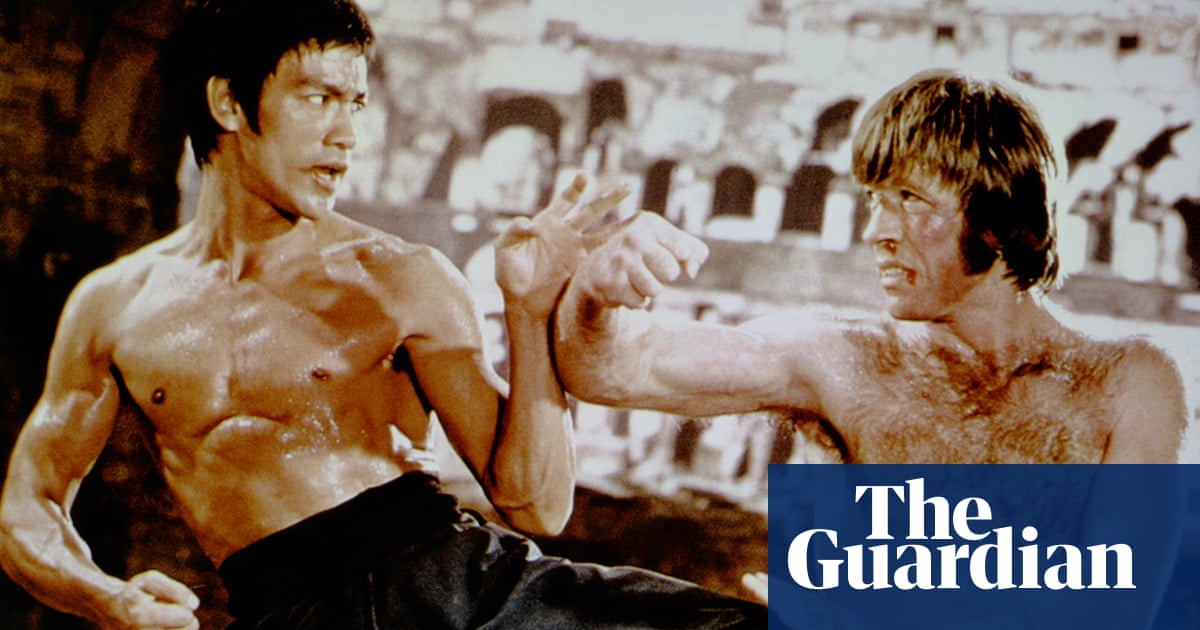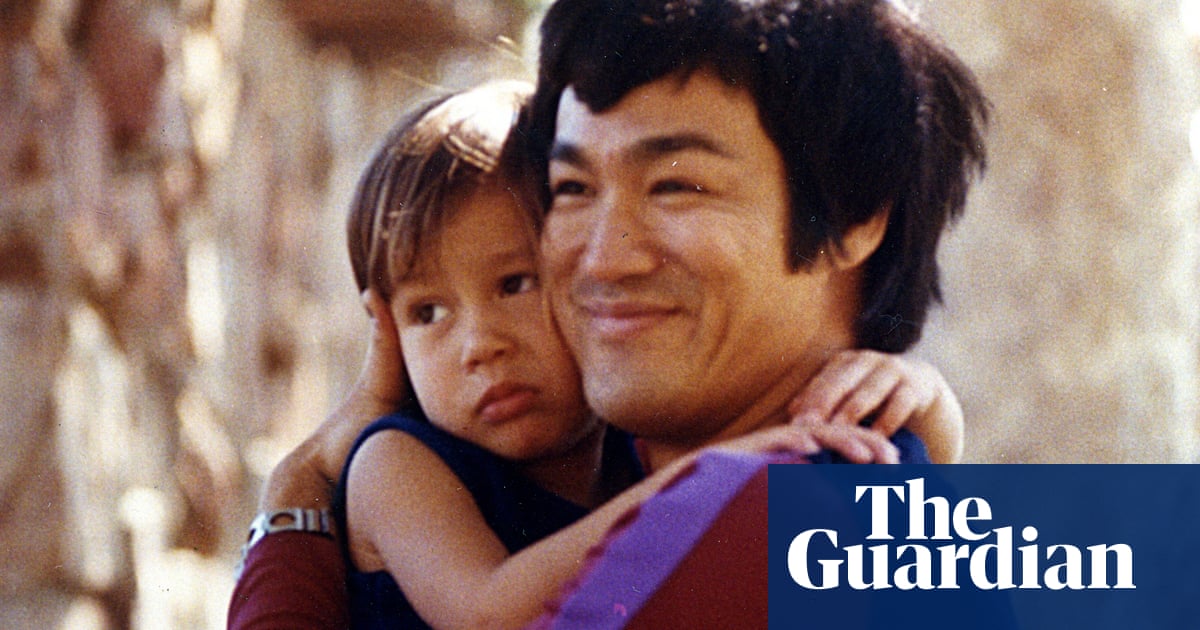
‘He had this disorder that filled him with too much energy,” recalled Robert of his older brother, Bruce Lee, the martial arts movie superstar nicknamed Never Sits Still by his friends and family. Speaking with writer Matthew Polly for his definitive 2018 biography, Robert continued: “Bruce was like a wild horse that had been tied up.”
This quote doubles as a perfect description for the dazzling way in which Lee – who died 50 years ago at 32 from cerebral oedema – fought on-screen. A demonic whirlwind of flying kicks, vengeful, air-popping nunchucks, feral animal noises (something Lee invented to unsettle his opponents) and double-fisted punches that hit enemies with the elegance of a championship fencer, Lee cemented martial arts in the global mainstream. And despite his short life, he smashed through the barrier that previously held back so many Asian actors in Hollywood.
With a stare like a tiger’s and a rapid close-combat style, Lee was an electric screen presence. His philosophy – Jeet Kune Do – prioritised a fluid and formless approach to fighting (“Be like water, my friend”), inspiring scores of action movie directors as well as Ultimate Fighting Championship fighters such as Conor McGregor and Royce Gracie.
However, one area of Lee’s legacy barely gets a mention in Polly’s biography: namely, his enormous impact on the world of gaming. “So many of the big gaming studios owe the Bruce Lee estate a ton of money,” Polly half jokes.
“Before Bruce Lee, you only saw lumbering punches in on-screen fights, but after him all the movies were filled with kicks and holds,” he says. “Even Batman started to fight like Bruce Lee. When the developers at the big Japanese and American gaming studios were growing up, they were all studying these Bruce Lee movies. So when gaming really took off in the 1980s, he was an obvious reference point. You know, I’m not sure the gaming industry wants to fully admit to the levels it has ripped off Bruce Lee.”
It is hard to disagree. The accepted father of beat ’em ups is the 1984 arcade classic Kung-Fu Master. It openly mirrored Lee’s posthumously released 1978 film Game of Death in the way it forced players to ascend a gloomy tower and fight through floor after floor of snarling bosses. Early tournament-style fighting games, including Karate Champ, Street Fighter and Yie Ar Kung-Fu, were reflections of the one-on-one, fight-to-the-death tournament that villainous drug smuggler Han hosted in Enter the Dragon.
Every major beat-’em-up title also had a character that replicated Lee’s tenacious spirit, with Street Fighter II’s Fei Long, Mortal Kombat’s Liu Kang, Dead or Alive’s Jann Lee and Tekken’s Marshall Law all moulded in his image. Critics say studios used different names to avoid the copyright fees, but there is also a feeling of homage. “Bruce has largely been used as a familiar landmark on the map into a fighting game,” says Ryan Hart, a professional British gamer who holds the record for the greatest number of consecutive opponents on Street Fighter V. “New users always have him as a familiar face to lean on as a go-to character when playing for the first time. Many fighting games include a Bruce Lee clone, but that was because he was such an influential figure in the combat world.”
As fighting games moved past linear one-on-one battles, Lee’s fighting style, and the way he smoothly dispatched huge crowds of bad guys, was also brought to mind by Renegade, Double Dragon, Final Fight, and Streets of Rage; all experiences where the lead heroes are regularly outnumbered, the path continuously shifts, and you feel forever pushed into a corner. In these games, you succeed only after discovering a weakness in your opponent – just as Lee does in Game of Death, when he targets 2.18 m (7ft 2in) giant Kareem Abdul-Jabbar’s sensitive eyes in their David v Goliath battle.
“You always get a sense that Lee’s character is in survival mode, moving almost on instinct alone, thinking two steps ahead about how he is going to take down each opponent, and creating space for himself so he doesn’t get overrun,” says Dave Cook, the author of Go Straight, a book that dissects the history of beat-’em-up games. “He has a lightning-fast ability to deflect or block incoming attacks with his feet. The beat-’em-up genre forces you to approach every battle this way, using every move at your disposal to thin out large crowds of enemies … It is not an exaggeration to say that Bruce Lee’s skills and movies have influenced gaming since the very first beat ’em up.”
There have been attempts to give Brue Lee his own official gaming adventure, but 1993’s Dragon: The Bruce Lee Story on the SNES and 2002’s Quest of The Dragon were both panned by critics for failing to replicate the whizz of his real-life blows. Terrence Masson directed the latter game, a launch title on the original Xbox created in conjunction with the Bruce Lee Estate. He worked with Lee’s former student Taky Kimura to motion-capture authentic Jeet Kune Do moves, but he admits it was a tricky task.
“Bruce Lee’s application of this style is so blindingly fast, so when Taky did the moves, we really struggled to capture them at the right frame rate. I had to get Taky to slow down the kicks altogether,” Masson reflects. “Bruce Lee was never manic or wild; he is always focused and, despite being in the centre, he also feels very peripheral too; back-fisting someone behind him while smiling at the opponent in front of him. I think our game showed just how uniquely original Bruce Lee was, in that we totally failed to capture his style in the gameplay. It just couldn’t be replicated with the technology back then.
“I remember our game being terrible. I needed a team that was three times bigger. If I were the Estate, then Quest of the Dragon would have left a bad taste in my mouth. It is one of my biggest regrets.”
A modern developer inspired by Bruce Lee is Danilo Barbosa, the creator behind indie game Two Strike in which ancient Japanese warriors battle to the death in landscapes that feel more like immersive paintings. He also cites Sifu as a recent game that channels Bruce Lee’s ability to deal with vast crowds of minions with an artistic yet vicious breed of fighting. “My favourite version of Bruce Lee is in Tekken, with Marshall Law and his lightning-fast punches and roundhouse kicks,” he says.
“Even now, in 2023, we still see a lot of action games trying to give the experience of being a great martial artist, which I’m sure are all being made by game developers that fell in love with Bruce Lee’s movies and the elation they felt while watching them. If we’re being honest, the beat-’em-up gaming genre should have probably been called the Bruce ’em up.”
As a sort of invincible James Bond character, the raw charisma that Lee brought to Enter The Dragon, which was released just weeks after Lee died and made more than $400m at the box office, inspired generations to start practising techniques like the praying mantis, sticky hands, and the one-inch punch. He became an enduring source of pride for a country that felt continuously disrespected, particularly by America and its Chinese Exclusion Act. “Bruce did more for the Chinese psyche than any dozen politicians or martyrs,” said Robert Clouse, the film’s director, in an interview in Polly’s autobiography. A fitting tribute, according to Polly, would be to make a next-gen action-adventure game that truly honours the Bruce Lee movies.
Polly says Lee deserves to be framed as a “forefather” of gaming, too. He might not have lived long enough to play as himself with a joypad, but that doesn’t change the transformative effect he had on game developers throughout history. To paraphrase the martial arts legend himself, it’s clear that without Bruce Lee, gaming would have lacked so much emotive content.
“Bruce’s first movie was literally called The Big Boss,” the biographer concludes. “The plot is the whole structure of gaming, period: you fight a bunch of losers and progress to the big boss. This writing was all Bruce’s idea; he fought for it.
“When you watched Superman, you knew Christopher Reeve couldn’t fight or fly, right? But pretty much everything Bruce did on screen, he could do in real life. He was a superhero who just happened to act, not the other way around. The people who make the magical into reality will always be inspiring, especially to video games developers. Now, Bruce deserves a great next-gen game based on his life. At the very least, I hope we start to frame him as one of the forefathers of gaming.”












